Battle Formations or Vyuha

Battle Formation or Vyuha
Battles are won or lost based on strategy and planning and the courage of the armies. It has been observed from history that even a smaller army can defeat a much bigger army depending on the strategy and planning on the battleground.
The Mahabharata was such an epic battle between truth and lies described elaborately in ancient Hindu scriptures. Either side had many great warriors fighting in the war. The battle formation or Vyuha represents the arrangement of troops to fight the war. The Vyuha were responsible for deciding the outcome of the battle.
Predicting the Vyuha the opposition deploys a Vyuha that can counter the enemy’s battle formation to attain an edge in the battle. Battle formation or Vyuha is always dynamic and can restructure based on the requirement and adapt according to the situation. If one part of the Vyuha suffers casualties the other part of the formation rearranges in such a manner to counter the threat.
The commander of the army decides to create a particular type of Vyuha based on the situation at hand. If the objective is to capture a warrior then such a battle formation is created that would constantly change and adapt unless the goal is achieved. An important part of the battle formation or Vyuha is to place the warrior in a suitable position according to their skills. The skilful fighters would be placed in a position where the chances of inflicting damage are maximum.
The battleground is a large place, to pass on any information for changes or adaptations in the Vyuha, the battle commander instructs his drum players to play a specific tune that contained a hidden message to align the other warriors in adaptation with the battle formation.
In case, a warrior dies in the war, a warrior of similar calibre is replaced in his position, so that the Vyuha remains in shape, and the purpose for setting up the Vyuha gets accomplished. This article highlights the different types of battle formations Vyuhas that were deployed in the epic battle of Mahabharata and their significance as depicted in ancient Hindu scriptures that lasted for 18 days.
Vyuhas Deployed in Mahabharata
Garuda Vyuha: Garuda is a large bird larger than an eagle. The bird is very agile and can cover up and beat the enemy with its large wings, sharp claws, and beak. This formation imparts fear among the opposition as it is very agile and causes large-scale destruction wherever this formation visits.
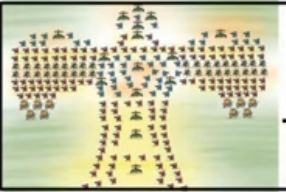
On the 2nd day of battle, this battle formation Vyuha was deployed by Beeshma, the commander in chief of Kauravas. The same formation was also deployed by Drona on the 12th day. On 2nd day Beeshma was stationed at the beak, with two other great warriors, Drona and Kritvarma placed as the two eyes of the eagle with Ashvatthama placed at the head.
The king of Trigartas, Bhagdatta made its neck, with the armies of Jayadrata, and Duryodhana was stationed at the back for protection. This formation placed exemplary warriors at its head and neck positions as they were the most vulnerable places.
Vajra Vyuha: Vajra battle formation resembled the Vajra, which is the main weapon of Lord Indra. This battle formation was created by Pandavas on the 1st and 7th days of the Mahabharata war. This formation had multiple layers of soldiers and infantry on all sides, and the main warriors were positioned in the middle. This war formation was led by Bheem on the first day and later on the 7th day, it was led by Drishtadhyumna.
Ardhya Chandra Vyuha: Ardhya Chandra battle formation resembled a crescent-shaped half-moon. The two flanks extend to engulf the opposition and spread across the entire battlefield. The two crescents are manned by extremely agile and powerful warriors with the dense inner part manned by the dense forces that protect the king and other warriors.
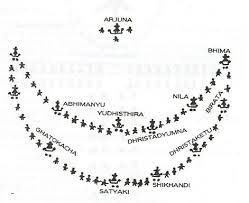
This formation was used by the Pandavas on the 12th day of the war. Arjuna and lord Krishna stood at the front with mighty Bheem and Abhimanyu guarding the flanks of the crescent. Ghatotkacha, Satyaki, and king Drupad were positioned at the center for the protection of Yudhistira.
Shakata Vyuha: Shakata battle formation is a T-shaped formation, with the head of T extending across the width of the battlefield. The length of the ‘T’ can be extended if required and included warriors at multiple positions surrounded by armies and elephants.
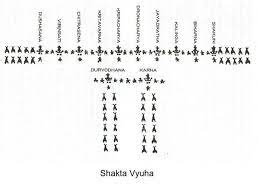
This battle formation was deployed by Drona on the 11th day. Again on the 14th day of the battle, this view was deployed along with a combination of different other Vyuha like Padma Vyuha and Soochimukha Vyuha to protect Jayadratha.
Vyuhas Deployed in Mahabharata
Soochimukha Vyuha: Soochimukha battle formation is a needle-shaped arrangement of warriors. This battle formation was not used as a standalone battle formation in the battle of Mahabharata. It was used as a combination with other Vyuha for protecting Jayadratha on the 14th day of the war.
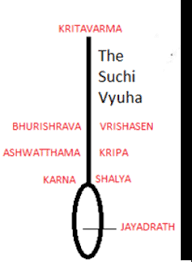
The needle had warriors like Kritvarma, Kripacharya, Karna, Shalya, and Ashwathama placed around the hole of the needle, with Jayadratha strategically placed at the center of the needle hole.
Padma Vyuha: Padma battle formation resembles a lotus formation where the armies place themselves as the petals of the lotus. This battle formation was deployed by Kauravas on the 6th day and as a combination of Vyuha on the 14th day to protect Jayadratha as the second layer of protection to prevent his death by the hands of Arjuna.
Asur and Daiva Vyuha: Asur and Daiva battle formation was deployed on the 10th day of the war. Asur Vyuha was deployed by Kauravas and to counter that battle formation Pandavas deployed the formation of Daiva Vyuha.
On the 10th day of the battle, and Pandavas had lost almost half their army at the hands of Bheeshma. On the previous night, Pandavas went to meet Bheesma to know the way he can be killed. Bheeshma had the power of wishful death, so no warrior could kill Bheeshma unless he decides to.
So he suggested to deploy the Daiva Vyuha with Shikhandi at the front. As he had taken a vow that he would not fight Shikhandi as she was born a female. He would drop his weapon on seeing Shikhandi, and that would enable Arjuna to shoot at him.
Oormi Vyuha: Oormi battle formation resembles waves of the ocean. The warriors were placed in the position of waves that can suddenly come at the front and unleash a wave of attack and then retrieve back to their previous position and the leading position is taken up by the next wave of warriors. This battle arrangement was deployed by Kauravas on the 8th day of the battle.
Bheeshma, Drona, Ashwathama, and Susharma formed a single wave, that was followed by Kripacharya, Brihadvala, and Duryodhana as the second wave and subsequently, the other waves followed. The sudden attack and retrieval was the main attraction of this battle formation.
Vyuhas Deployed in Mahabharata
Sringataka Vyuha: Sringataka battle formation was opted by Dhrishtadyumna, the commander general of the Pandava forces to counter the Oormi Vyuha on the 8th day of the battle. This battle formation resembles the horns of a large bull. The objective of this battle formation was to pierce the waves and segregate the warriors.
Arjuna, Bheema, and Satyaki were placed at the pointed end of the horns and the head while Yudhisthira was guarded by Nakul and Sahadev at the center of the bull.
Sarvatobhadra Vyuha: Sarvatobhadra battle formation was deployed by Kauravas on the 9th day of the battle of Mahabharat. This battle formation resembles a fort that is safe from all sides. All the main Kaurava warriors were guarding this battle formation with Bheeshma at the front, guarded by Drona, Kripacharya, Shakuni, Kritvarma, and other sons of Dhritrashtra.
Sarvatomukhi Danda Vyuha: Sarvatomukhi Danda battle formation resembled a large wheel attached to a long stick.
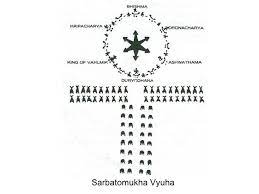
The circular portion had six warriors with their armies, and the stick contains the remaining warriors and their supporting armies. This battle formation was deployed by Kauravas on the 1st day of the battle.
Makara Vyuha: Makara battle formation resembles an alligator. The warriors were all placed in strategic places to counter any threat. This Vyuha was deployed by Kauravas on the 5th and 16th day and the same battle formation was used by Pandavas on the 6th day.
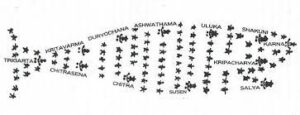
On the 6th day, Bheema was given a strategic position in this formation, he was given the freedom to go out at his will and kill many warriors with his mace and return to the formation.
Vyuhas Deployed in Mahabharata
Mandala Vyuha: Mandala battle formation was deployed by Kauravas on the 7th day of the battle. This formation comprised many semicircles, each led by a warrior, and these semicircles again formed a part of a bigger semicircular formation.
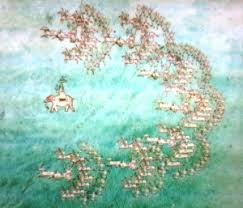
One set of warriors with its army can break into the opposition and create damage before returning to resume the battle formation.
Krauncha Vyuha: Krauncha battle formation resembles a Heron which is a large bird with a large wingspan and a large beak. This is an offensive battle formation similar to the bird that expands its wings to show its strength and suddenly attacks with its beak and claws.
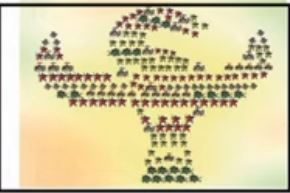
Most agile and strong warriors were placed in the beak, neck, and wings to formulate a fast attack. This battle formation was used both by Kauravas on the 2nd day and by the Pandavas on the 6th day. Arjuna was at the beak of this formation, with other warriors like Satyaki forming the neck, and Bheema and Dhrishtadyumna forming both the wings of this Vyuha.
Chakra Vyuha: Chakra Vyuha was the most respected and toughest battle formation. This formation consisted of 6 to 7 layers of armies and warriors. The deeper one penetrates toward the center of the circle, the number of warriors and the concentration of soldiers became denser.
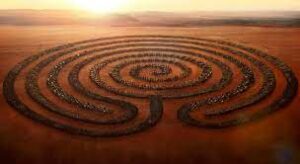
Each layer of soldiers keeps on spinning in a circular motion. The warrior needs to have special skills to enter this battle formation, as the vacant place left by the death of a warrior or soldier would be quickly occupied by other soldiers.
Duryodhana was very angry when every day he heard about the death of some of his brothers, and the Pandava warriors were still alive. He requested Drona to kill at least one Pandava warrior, so Drona took a vow to kill a Pandav and deployed this battle formation on the 13th day of the battle.
Drona was aware that Arjuna knew how to conquer this battle formation; hence he requested Trigarta and Samsaptakas to engage Arjun in battle and lure him far away from this battle formation. Among the Pandavas, the knowledge of conquering Chakra Vyuha was only known to Arjuna, Lord Krishna, and Pradyuman, son of Lord Krishna.
Abhimanyu told Yudhisthira that he was also aware of the process to enter this Chakra Vyuha when he was in his mother’s womb and Arjuna was explaining about this Vyuha to his Subhadra. He however could not hear the process of getting out of it as his mother fell asleep.
Apart from Drona only Bheeshma knew the entire Chakra Vyuha from the side of Kauravas. The study of this special battle formation required absolute mental agility and concentration. Jayadratha played a crucial role in the success of this Chakra Vyuha.
The plan from Pandava was that as soon as Abhimanyu enters the Chakra Vyuha, he would be accompanied by the Pandava warriors like Bheema, Sahadev, and others to protect Abhimanyu from opposition attacks.
As Abhimanyu entered the Chakra Vyuha, Jayadratha immediately filled up the position and blocked the entire Pandava brothers from entering the Vyuha for the entire day. Abhimanyu was left all by himself inside that Vyuha.
It so happened during the period when Pandavas were residing an exiled life in the Jungle, Jayadratha, who was a womanizer and husband of Dushayala, the only sister of Kauravas was on a hunting expedition. He got attracted to Draupadi and wanted to abduct her. When Pandavas came to know of this arrogance, they caught Jayadratha and wanted to kill him. Yudhisthira ordered to release him after shaving his head in such a way as to make him look laughable.
This angered Jayadratha, and he intensely prayed to Lord Shiva and obtained the blessing that apart from Arjuna, he would have the courage to hold the entire Pandavas brothers for entire one day. Abhimanyu was such a great warrior that he was able to enter the sixth layer where he was surrounded by all the Kaurava Warriors. A battle followed that resulted in the death of Abhimanyu, who fought fiercely and bravely.




 (1 votes, average: 5.00 out of 5)
(1 votes, average: 5.00 out of 5)


